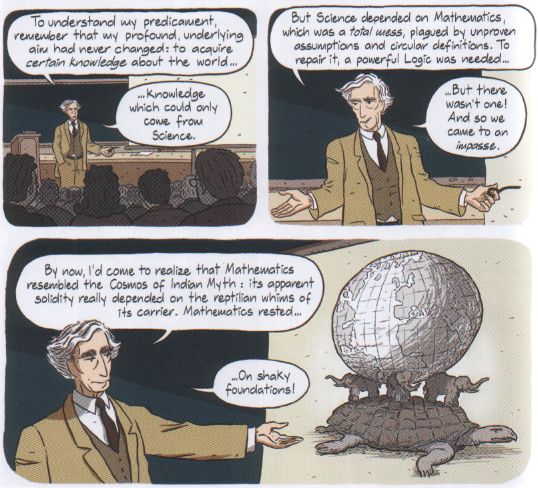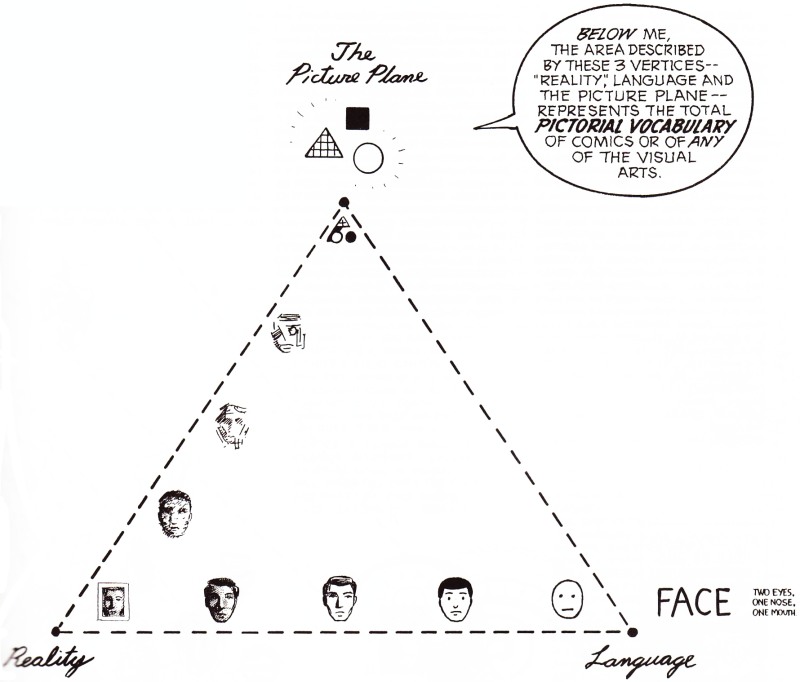Propaganda’s Book Of 2009: If you read just one graphic novel that lays out the fundamental foundations of mathematical logic….
Written by Robert Bruton, FORBIDDEN PLANET
Friday, 25 December 2009 22:43
“What Is Logic? ….. My way of telling you the story of Logic will be through the tale of one of it’s most ardent fans. Myself!” – Betrand Russell from the pages of Logicomix.
Here’s a comic you wouldn’t have seen a few years ago – a detailed study of Bertrand Russell’s life and his work; of mathematics, of logic, of philosophy and, like it says right there on the cover; an epic search for truth. There really is no simple way of defining Logicomix, except by virtue of it’s absolute brilliance. Logicomix is unquestionably my book of the year, but, just as Betrand Russell ultimately considered his life’s work rather a failure (as any attempt to create a universal truth in mathematics or science would be), I’m not entirely happy with my words here. Simply because I rather lack the words to describe to you exactly how good Logicomix is.
Logicomix tells the story of Bertrand Russell’s life. A giant in the fields of Mathematics, Logic and Philosophy, he was a truly radical and incredibly important thinker whose works attempting to establish a universal, fundamental foundation for mathematics have influenced many of the world’s greatest minds since then.

(Foundations that Russell would spend a lifetime first tearing down and then attempting to rebuild. From Logicomix. Published by Bloomsbury.)
Russell’s search for a new, absolute truth in mathematics and logic as detailed in Logicomix encompasses most of the legendary figures in the field; Gottlob Frege, David Hilbert, and Kurt Gödel, and perhaps most importantly his impassioned student; Ludwig Wittgenstein, who would later destroy much of Russell’s work through his own ideas on Mathematics. But, as the authors mention, it’s Russell’s pioneering work that allows these incredible thinkers, Wittgenstein included, to move mathematics and logic forwards. The story may have it’s roots in the movements of the time, but a lot of the narrative, the required meeting of minds, as freely admitted by the authors in the afterword, is a result of a process of simplification, reduction and outright invention. This reworking of historical reality into the spellbinding narrative within the pages of Logicomix is fitting, forming a new historical reality in much the same way as Russell et al were concerned with creating a new reality for the fundamental principles of the world they lived in.
But whilst a graphic novel on the subject of complex mathematical and logical ideas may sound a little dry, Logicomix is anything but. The ideas Russell was trying to expound are incredibly dense, hugely technical and amazingly complex mathematical ones (famously Russell and Whitehead took an incredible 362 pages, 15 more than in this graphic novel, to prove that 1 + 1 = 2). But never in Logicomix do the authors allow these incredibly complex ideas to get too far beyond the reader’s grasp.

(A moment that Russell himself describes as – “Think of that: 362 pages to prove what every child knows”. A small glimpse into the obsessive nature of the field. From Logicomix. Published by Bloomsbury.)
To keep us readers up to speed and involved the authors don’t simply tell a tale of mathematics and logical thought, instead they use not one, but two simple framing devices to make the work accessible. The first is Russell himself, delivering a talk in America during 1939, as the debate on whether to enter the second World War or continue an isolationist policy rages. This philosophical debate on the question of entering the war is a perfect backdrop to allow Russell to tell a tale of his life and the complicated ideas of mathematics, logical thinking and philosophy that would become an obsession, defining his life and tormenting his every moment. The nature of his talk, spinning out biographical facts, philosophical questions and a detailed look at mathematics and logic along the way is laid out as a parable for the audience, both in Russell’s lecture and the audience reading this graphic novel.
The second framing device occurs between the chapters of Russell’s life, when the entire narrative is suspended and the creators of the graphic novel appear as themselves, discussing the work in progress. It’s a simple but marvellously effective way to break up a complex and difficult story, allowing the readers to catch their breath, absorb all they’ve read before and be gently guided by the creators of the story. It’s also functions as a simple method to incorporate the essentially self-referential nature of much of mathematics – by including themselves in their work, discussing the work in progress, the authors are as self-referential as much of Russell’s own work, including his ground-breaking (and Logician breaking at the time of it’s publication) Russell’s Paradox – here beautifully illustrated with Russell’s own parable of the Barber….

(And who will shave the barber? The essentials of Russell’s Paradox laid out beautifully simply. Such complex ideas, so easily explained. From Logicomix. Published by Bloomsbury.)
Of course, Russell’s ultimate goal, to create an absolute fundamental foundation for mathematics and logic, was forever to be an elusive, obsessive dream. The authors perfectly create the incredible sense of yearning in Russell’s life for this impossible goal, something that overwhelmed everything; his marriages, his children, his very sanity – all would come second to this impossible dream. And it’s all beautifully, evocatively detailed in the pages of Logicomix.
But any graphic novel depends not only on the creativity and insight of it’s writers, but on the skill and technique of it’s artist. And here, the art team of Papadatos, and his colourist Di Donna, inkers Karatzaferis & Paraskevas and even visual researcher and letterer Bardy prove more than equal to the arduous task of visualising the momentous events of the work and making it a seamless, visual delight throughout. It’s never a chore to look at these pages of talking heads, the stylistic touches throughout, the beautiful compositions of both panels and pages, the architecture, the body language and expressions of the characters, is all so well done that the work just flows, effortlessly, allowing the absorption of the ideas of the piece to happen naturally and is as far from an arduous treatise on higher mathematics as you could possibly imagine.
Throughout the graphic novel, with the talking heads doing the explaining, I was reminded of Scott McCloud delivering his treatises on comics in Understanding Comics and it’s sequels. Interestingly there are even a few direct comparisons between Logistics and McCloud’s theories on comics; specifically in Wittgenstein’s “Tractatus Logico-Philosophicus” and it’s dealing of modelling the world with representation and language. But was it McCloud who was influenced by Wittgenstein or was it the creators of Logicomix who were influenced by McCloud’s arguments and visuals? Either way it’s all fascinating stuff.


(The transition from reality through to modelling by language and the parallels between Logicomix analysis of Witgenstein’s work in mathematics and McCloud’s pictorial vocabulary. Influences? But who influences who?)
Logicomix is one of those books that comes along every few years and completely changes the way I look at things. I’ve always been a science geek, loving the ideas of theoretical physics/pop science since I was at school. But Logicomix has now opened up an entire new realm to me, of mathematics, logical thinking and philosophy. And it’s done it in a thoroughly entertaining and concise graphic novel that ranks as one of the best stories I’ve read for many a year.
With something this incredibly complex, original and utterly wonderful, I can only implore you to give it a try. Logicomix is my book of the year, but it’s one that seems to have slipped under a lot of people’s radar. Please, please, I implore you, don’t let it slip under yours.
As an added extra here’s part one of a three part series on You Tube looking at the making of the book. Fascinating….
